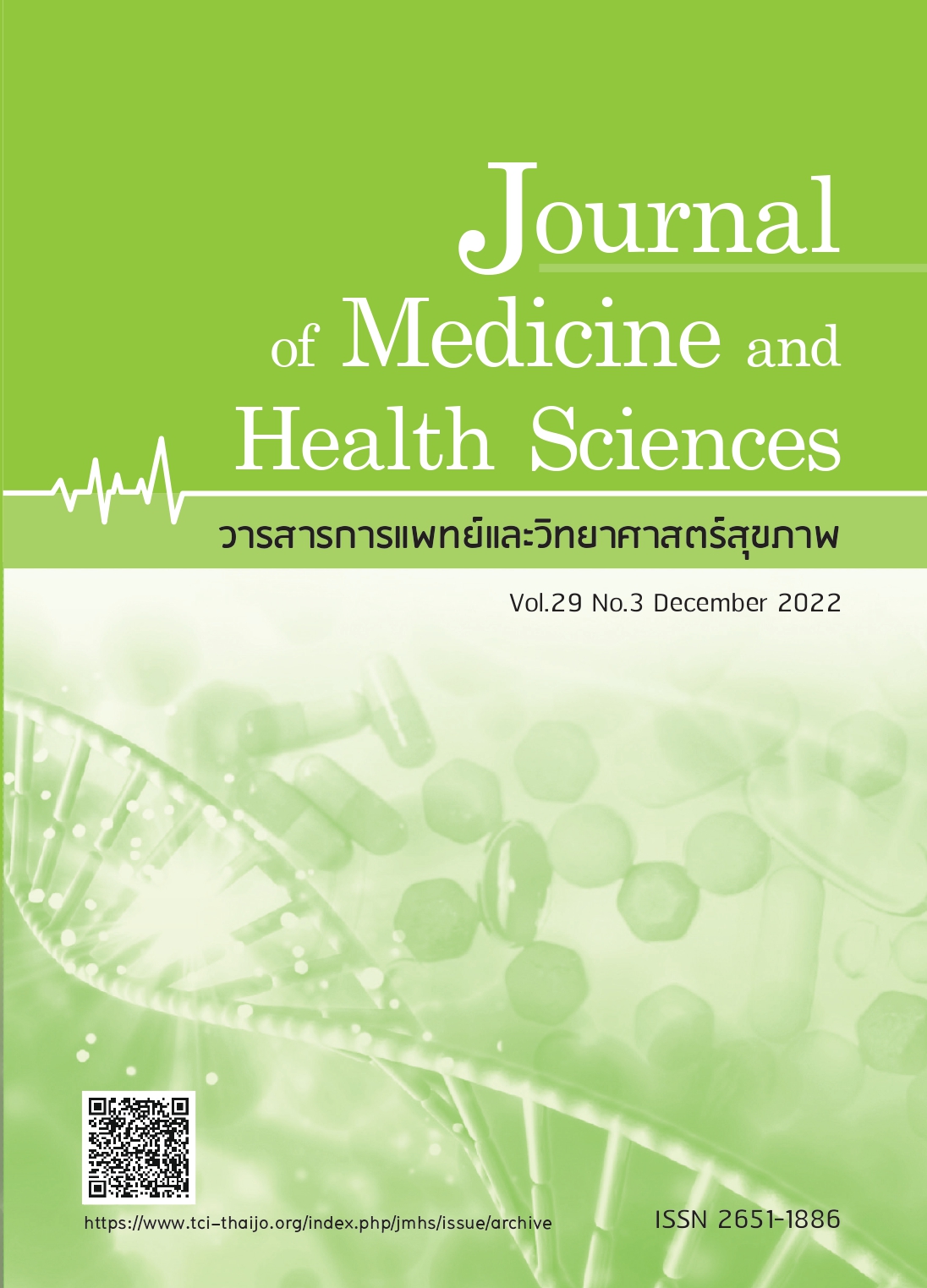Time to assess the daily living activities of stroke patients
Keywords:
Post-stroke patients, Recovery time, Activity of daily living (ADL)Abstract
Abstract
Post-stroke patients have different recovery times. Previous studies have shown that the assessment of recovery time in post-stroke patients regarding activities of daily living (ADL) ranged from one week to over one year. However, the most common time was three to six months, respectively. The pattern of daily activity among post-stroke patients indicated that the optimal recovery time is within the first 13 weeks, and then 13 to 20 weeks afterwards, when the speed of ADL recovery decreased and became stable. In addition, the severity of a stroke influenced the recovery time for each patient. According to the current guidelines for assessing the daily activities of post-stroke patients, it suggested that ADL should be assessed within the first 48 hours after the stroke incident and may assess every week within the first month. The ADL also suggested that assessment should be conducted again in the third and sixth month after discharge, respectively. Therefore, the ADL assessment should begin within 48 hours after stroke incident, and it should be performed again at least three times to assess the changes. The severity of strokes should be considered when assessing ADL. Whenever the recovery in the activity of daily living in post-stroke patients is stable, assessing ADL is still important and should be performed at least twice afterwards.
References
Worathitianan B. Improved stroke fast track strategy leads to 6 minutes door-to-needle time. J Thai Stroke Soc 2020;19(1):5-15.
Neurological Institute of Thailand. Clinical practice guidelines for ischemic stroke. Department of medical services; 2019.
Winstein CJ, Stein J, Arena R, et al. Guidelines for adult stroke rehabilitation and recovery: A guideline for healthcare professionals from the American Heart Association/American Stroke Association. Stroke 2016;47(6) 98–169.
Neurological Institute of Thailand. Clinical practice guidelines for stroke rehabilitation. Department of medical services; 2007.
Duncan PW, Jorgensen HS, Wade DT. Outcome measures in acute stroke trials: A systematic review and some recommendations to improve practice. Stroke. 2000;31(6):1429–38.
Hendricks HT, Van Limbeek J, Geurts AC, et al. Motor recovery after stroke: A systematic review of the literature. Arch Phys Med Rehabilitation 2002;83(11):1629–37.
Horgan NF, O’Regan M, Cunningham CJ, et al. Recovery after stroke: A 1-year profile. Disabil Rehabil 2009;31(10):831–9.
Saver JL. Time is brain - Quantified. Stroke [Internet]. 2006;37(1):263–6. Available from: https://www.ahajournals.org/doi/10.1161/01.STR.0000196957.55928.ab
Robert Teasell MD NHM. Rehabilitation. Background concepts stroke rehabilitation.2018;1–34.
Murphy TH, Corbett D. Plasticity during stroke recovery: From synapse to behavior. Nat Rev Neurosci 2009;10(12):861–72.
Jørgensen HS, Nakayama H, Raaschou HO, et al. Outcome and time course of recovery in stroke. Part I: Outcome. The Copenhagen stroke study. Arch Phys Med Rehabilitation 1995;76(5):399–405.
Chueluecha C. Rehabilitation for ischemic stroke. TMJ 2012;12(1):97–111.
Rojanapitayakorn P. Predictors for outcome and recovery time of cerebral venous thrombosis and ischemic stroke in Suratthani hospital. J Thai Stroke Soc 2019;18(2):5-14).
Jorgensen HS, Nakayama H, Raaschou HO, et al. Stroke: Neurologic and functional recovery the Copenhagen Stroke Study. Phys Med Rehabil Clin N Am 1999;10(4)887–906.
Tilling K, Sterne JAC, Rudd AG, et al. A new method for predicting recovery after stroke. Stroke 2001;32(12):2867–73.
Kwakkel G, Kollen B, Twisk J. Impact of time on improvement of outcome after stroke. Stroke 2006;37(9):2348–53.
Cramer SC. Recovery after Stroke. Continuum (Minneap Minn) 2020;26(2):415–34.
Duncan PW, Goldstein LB, Matchar D, et al. Measurement of motor recovery after stroke. Stroke 1992; 23:1084–9.
Boulanger JM, Lindsay MP, Gubitz G, et al. Canadian stroke best practice recommendations for acute stroke management: Prehospital, Emergency Department, and acute inpatient stroke care, 6th Edition, Update 2018. Int J Stroke. 2018;13(9):949–84.
Massakulpan P. Clinical Practice Guidelines for stroke rehabilitation. Department of medical services; 2016.
Quinn TJ, Langhorne P, Stott DJ. Barthel index for stroke trials: Development, properties, and application. Stroke 2011;42(4):1146–51.
Yi Y, Ding L, Wen H, et al. Is Barthel index suitable for assessing activities of daily living in patients with dementia? Front Psychiatry 2020;11(May):1–11.
Kwakkel G, Veerbeek JM, Harmeling-Van Der Wel BC, et al. Diagnostic accuracy of the barthel index for measuring activities of daily living outcome after ischemic hemispheric stroke: Does early poststroke timing of assessment matter? Stroke 2011;42(2):342–6.
Uyttenboogaart M, Stewart RE, Vroomen PCAJ, et al. Optimizing cutoff scores for the Barthel Index and the modified Rankin Scale for defining outcome in acute stroke trials. Stroke 2005;36(9):1984–7.
Barrett KM, Ding YH, Wagner DP, et al. Change in diffusion-weighted imaging infarct volume predicts neurologic outcome at 90 days results of the acute stroke accurate prediction (ASAP) trial serial imaging substudy. Stroke 2009;40(7):2422–7.
Hsueh IP, Lin JH, Jeng JS, et al. Comparison of the psychometric characteristics of the functional independence measure, 5 item Barthel index, and 10 item Barthel index in patients with stroke. J Neurol Neurosurg Psychiatry 2002;73(2):188–90.
Duffy L, Gajree S, Langhorne P, et al. Reliability (Inter-rater Agreement) of the barthel index for assessment of stroke survivors: Systematic review and meta-analysis. Stroke 2013;44(2):462–8.
Teasell R, Pereira S, Cotoi A. Chapter 22: The rehabilitation of severe stroke. Evidence-Based Rev Stroke Rehabilitation [Internet]. March 2018 [cited 2021 May 16];1–23. Available from: http://www.ebrsr.com/sites/default/files/v18-SREBR-CH22-NET-1.pdf
Teasell R, Hussein N, Mirkowski M, et al. Stroke rehabilitation clinician handbook. Hear Stroke Found [Internet]. 2020 [cited 2021 May 16] ;1–60. Available from: http://www.ebrsr.com/sites/default/files/EBRSR%20Handbook%20Intro.pdf
Downloads
Published
How to Cite
Issue
Section
License

This work is licensed under a Creative Commons Attribution-NonCommercial-NoDerivatives 4.0 International License.



